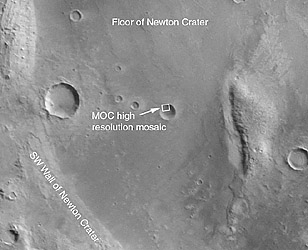Water on Mars?
 Within Newton Crater we see a bizarre formation, the north wall of a small crater. This crater measures about 4.4 miles across. The north wall of this depression has a great many narrow gullies leading down into its depths. Did water emerge from beneath the Martian surface, or did it originate in meteors striking Mars? That which looks like a great smooth lake with lobes and fingers at the bottom is obviously not water because of the climate of this planet, but it certainly l0oks like a liquid flowed from above and left features water might make.
Within Newton Crater we see a bizarre formation, the north wall of a small crater. This crater measures about 4.4 miles across. The north wall of this depression has a great many narrow gullies leading down into its depths. Did water emerge from beneath the Martian surface, or did it originate in meteors striking Mars? That which looks like a great smooth lake with lobes and fingers at the bottom is obviously not water because of the climate of this planet, but it certainly l0oks like a liquid flowed from above and left features water might make.In Walt Brown's Book, In the Beginning: Compelling Evidence for the Creation and the Flood, he theorizes that enormous amounts of rock and water were expelled from beneath the surface of the earth at supersonic speeds during the Great Flood. Some of this material escaped the earth's atmosphere and some fell back. That which escaped became comets, asteroids and meteors. Some of this material impacted other bodies in our solar system. We weren't there to see this happen ( if this is the way it all actually came about), but this strange event in the Newton Crater on Mars may well have occured at the time of meteor impacts. There seems little reason to interpret this phenomenon in terms of millions or billions of years when the craters produce cataclysm. This evidence seems to agree well with a young age for our solar system.
President Clinton once spoke enthusiastically about a chunk of (presumeably) Martian rock found on earth. Some scientists felt the rock contained evidence of life on Mars. Evidently opinion has swung the other way about the "life" idea, but the Martian origen is still upheld. Doesn't it seem logical that if we could receive material from Mars, then Mars might also receive material from the earth.
Water on Mars? Maybe. Maybe it resulted from God opening the fountains of the deep (worldwide) on earth a few thousand years ago. To explore the mechanics of how this might have happened, read Brown's book. Whether you agree or disagree with the hydroplate theory, the evidence Brown examines and interprets is intensely fascinating.
Images Credit: NASA/JPL/Malin Space Science Systems


1 Comments:
Hi!
By Anonymous, at 8:15 AM
Anonymous, at 8:15 AM
Post a Comment
<< Home